Memory & Learning Breakthrough: It Turns Out That The Ancients Were Right
Author’s Note: This article was written over 60 hours with love and care using the blockbuster mental model.
Research confirms.
Have you ever wondered…
What’s the fastest, most effective way to learn?
What’s the secret to remembering what you learn?
When it comes to learning how to learn, these are the big questions. If you have a better answer to them, you will be more successful. Period.
Learning faster than others is the ultimate, lasting competitive advantage. Self-made billionaire Charlie Munger, Warren Buffett’s long-time business partner, captures this truism in the following quote:
Without Warren Buffett being a learning machine, the [Berkshire Hathaway investing] record would have been absolutely impossible. The same is true at lower walks of life. I constantly see people rise in life who are not the smartest, sometimes not even the most diligent, but they’re learning machines. They go to bed every night a little wiser than when they get up.
—Charlie Munger
This is why I’ve spent the last several years researching, writing about, and teaching the subject of learning how to learn to thousands of students and more than ten million readers.
As time has passed, a few methods have proven particularly life-changing and have now become pillars of my daily learning routine. These include the practices of:
Collecting the most useful, universal, and timeless mental models in the world to build a base of rare and valuable knowledge that is instantly practical, applies across domains, will never expire, and that will compound—all to become a modern polymath.
Using the 5-Hour Rule to set aside a minimum of 5 hours per week (typically 25 for me) for deliberate learning.
Doing Fractal Reading to find breakthrough knowledge that could change the trajectory of my life.
Using the 10,000-Experiment Rule to constantly find new, high-leverage ways to test my knowledge in the real world.
This article introduces a fifth pillar that is both profound and obvious. It has been tried and true for thousands of years, yet it’s also a modern breakthrough backed by research.
The idea is simple: Teach what you learn—as soon as you learn it.
Introducing The Explanation Effect
I don’t know what I think until I write it down.
―Joan Didion
Research shows that when we teach what we learn, something magical happens in our minds. We suddenly notice mistakes in our thinking. We have more creative insights. Our ideas become sharper. We remember what we learned for longer. We see patterns more effectively. We get feedback that improves our idea. This magic is what I call the Explanation Effect mental model. And it even applies when we teach concepts to ourselves by journaling, mind mapping, or talking out loud.
You’ve experienced the power of the Explanation Effect mental model if you have ever:
Learned something new about what you were teaching as you were preparing for or actually teaching it.
Started unconsciously deliberating on (even dreaming about) a presentation days before you actually delivered it.
Started explaining an idea to someone else only to realize that you didn’t actually understand the idea as well as you thought you did.
Gotten new ideas from a student, reader, or conversation partner that helped take the idea to the next level.
Here’s what’s happening on a deeper level that creates the magic of the Explanation Effect mental model…
How The Explanation Effect Helps You Learn Faster
Learning is NOT just about taking in information. In my experience coaching hundreds of people on learning how to learn, almost no one has a system for processing information. It’s almost as if people just expect the learning to happen automatically after they read a book, listen to a podcast, watch a lecture, or have a life experience. Looking at text and expecting to learn is not far off from looking at food and expecting to get its nutrients. We need to digest our life experiences just like we digest our food. Without some form of active processing, almost everything we read is lost within weeks.
As the diagram below shows, absorbing information is just the first step in the universal process for learning, which I call the learning loop.
The information we absorb must be transformed in our brains to make it understandable and usable. Then, we must take action in the real world to get results. Finally, feedback from the real world helps us improve the whole learning process before we go through the loop again.
Teaching is powerful because it helps at ALL four stages.
When we incorporate teaching into our daily lives, we exponentially increase our learning potential, build deeper relationships with those around us, and make a bigger impact on the world.
Not only that, teaching is compelling on a whole other level NOW because we live in a digitally connected world…
How A Digitally Connected World Exponentially Increases The Power Of The Explanation Effect
When you give knowledge away, not only do you also keep it, it actually grows stronger in your mind. It’s easy to take this for granted. But, just consider how wonderful it would be if you could get rich by literally handing people money. Yet that’s exactly how knowledge works!
The leverage of teaching is almost unfathomable. We can spend years learning a concept and yet transfer it to someone else in minutes. That’s 100x leverage.
The Internet allows us to share our knowledge on a whole other scale. Rather than just sharing the knowledge in our head with one person through conversation, we can share it with millions of people instantly at no cost. There is NOTHING more scalable than teaching.
Teaching is on track to becoming one of the most lucrative professions. As more people get used to regularly buying online courses and paying for coaching, the number of occupations where people get paid primarily for teaching is exploding. We now have coaches, managers, thought leaders, mentors, authors, investors, advisors, journalists, facilitators, and consultants, to name a few. There is also a small but growing breed of celebrity teachers who generate millions of dollars and impact millions of people. For example, podcaster Joe Rogan’s audience is bigger than any network TV news show and is rumored to be on track to earn $100 million this year. He has done all of this with only a few people on his team. (Note: If you want to become a celebrity teacher, you can get started here.)
Teaching may be the future of the sharing economy. Two of the biggest businesses created in the last 10 years are Uber and Airbnb. These sharing economy businesses are based on the idea that the biggest physical assets we own—our house and car—often go unused. Therefore, we can make extra money at minimal cost to us by renting them out. I’d argue that the ultimate unused asset is our brain. It stores the most useful knowledge we have, and most of that knowledge is only shared with a tiny fraction of the people it could be.
What does all of this mean?
The Big Idea: Teaching Is One Of The Most Important DAILY Habits We Should ALL Cultivate
At the end of the day, we are ALL each other’s teachers on some level—whether it be as colleagues, friends, mentors, parents, or spouses. As a commenter on this article wisely noted:
You don’t have to have an audience to teach nor do you have to be an expert. You’ll grow your audience and be seen as an expert by teaching.
We all can and should incorporate the Explanation Effect mental model into our daily lives.
In other words, teaching isn’t just for teachers. We are teaching when we:
Have a conversation with a friend about a book we read.
Share a new production technique with a coworker
Explain an important life lesson to our kids.
Participate in a mastermind.
Coach an employee through a vexing challenge.
Share what we learned from a customer with our boss.
Explain a difficult concept to ourselves out loud.
Teaching others what we have learned is one of the noblest things we can do with our short time on this planet. Knowledge is an innately social organism. It wants to move, to land in other’s minds, to connect to other knowledge. When we connect two ideas in our head into a new insight, we get a rush of bliss. Eureka! We get a second wave of bliss when we share that insight and others find it genuinely useful. Teaching is the oxygen knowledge uses to spread, grow, and thrive. We humans are designed to learn and teach.
This article is the most comprehensive overview of the Explanation Effect that I’m aware of. It is the result of more than 150 hours of research over three years from a team that includes myself, a PhD student (Thanks Kavya Sharman!), and several others.
Now that we have a basic understanding of the Explanation Effect, let’s dive into some of the most interesting research on it and learn how the world’s most successful entrepreneurs, leaders, and executives use it to become smarter…
Bill Gates, Oprah Winfrey, Warren Buffett All Use The Explanation Effect
No one learns as much about a subject as one who is forced to teach it.
—Peter Drucker
In 2014, two veteran education researchers published a learning framework that encapsulates and synthesizes hundreds of studies on best practices for learning.
The following chart summarizes the findings. To sum up, teaching ourselves and teaching others are the most effective ways to learn:
This power of teaching has been echoed throughout time, all the way back to the Greeks and Romans. The famous Roman philosopher and statesman Seneca once proclaimed, “While we teach, we learn.” Socrates pioneered the Socratic Method of using dialogue to both teach and learn. And Aristotle lauded the power of teaching repeatedly, calling it “the highest form of understanding.”
Many of the world’s top entrepreneurs, creatives, scientists, and leaders have used the Explanation Effect mental model as a central approach to their work. These include Albert Einstein, Marie Curie, Thomas Edison, Leonardo da Vinci, Ray Dalio, Warren Buffett, Bill Gates, Charlie Munger, Oprah Winfrey, and many more. They’ve done this through various methods:
Creating Content (book, annual report, blog). In a CNBC interview, Warren Buffett goes so far as to say that he would rather be remembered as a teacher than an investor. And, when you think about it, that is how he probably will be remembered. When you watch his company’s annual shareholder meeting (which sells out to tens of thousands of attendees) and listen to the questions, it’s clear that many, if not most of the attendees, are there for life and business wisdom. Buffett regularly has made time to speak to students throughout his career and millions read his annual shareholder letter despite not owning Berkshire Hathaway stock. Buffett has said, “I regard the annual report and the annual meeting as a teaching venue.” In 2016, Buffett took things a step further and wrote a 50-year retrospective. Writing about the report, he says, “As you might guess, I ended up being the prime beneficiary of this effort. There’s nothing like actually writing something out to clarify thinking.”
Or consider that Bill Gates, one of the richest people in the world, is co-chairman of the world’s largest foundation and founder of the world’s second-largest company. Yet, over the last few years, he has spent untold hours writing hundreds of blog posts that focus on sharing what he’s learning in the books he’s reading and from the innovative people he meets around the world. Basically, in his blog, Gates is teaching.
Journaling. Journaling is a form of teaching yourself. Leonardo da Vinci filled tens of thousands of pages with sketches and musings on his art, inventions, observations, and ideas. Albert Einstein amassed more than 80,000 pages of notes in his lifetime. Former President John Adams kept over 51 journals throughout his life. Thomas Edison wrote more than five million pages of notes. Read more about famous journalers in Why Successful People Spend 10 Hours A Week On Compound Time.
Masterminding. In masterminds, a group of individuals come together with the goal of mutual improvement. Many of the most famous entrepreneurs, creatives, and leaders throughout history employed masterminds. For example, Theodore Roosevelt’s Tennis Cabinet included friends and diplomats who exercised together daily and debated the issues facing the country. Benjamin Franklin created a “mutual improvement society” called the Junto that gathered each Friday evening to learn from each other. The Vagabonds were a group of four famous friends—Henry Ford, Thomas Edison, Harvey Firestone, and John Burroughs—who took road trips each summer: camping, climbing, and sitting around the campfire discussing their various scientific and business ventures and debating the pressing issues of the day. I personally lead or participate in several in-person mastermind events per year. In addition, I participate in a weekly virtual mastermind.
Turning Your Job Into A Platform To Learn And Teach. When Oprah Winfrey first launched her talk show, it became an overnight success based on sensational stories. As her career progressed though, she turned the show into a teaching platform. First, the shows morphed into topics that she was learning about and applying to her own life. Then, she started a book club. Later a magazine. I started the Mental Model Club, in part, because I wanted to force myself to more deliberately learn mental models.
Learning Conversations. Many of the most remarkable insights in history came from pairs of friends who spent years dialoguing, conversing, and debating with each other. Nobel laureates Daniel Kahneman and Amos Tversky spent years walking for hours a day, sharing and laughing about cognitive biases they noticed. Their collaboration is brilliantly detailed in Michael Lewis’ book The Undoing Project (recommended reading). Famous novelists J.R.R. Tolkien and C.S. Lewis shared their work with each other and set aside Mondays to meet at a pub to converse. Francis Crick and James Watson, ****the co-discoverers of the structure of DNA, batted ideas back and forth relentlessly, both in their shared office and during daily lunches in Cambridge. Crick recalled that if he presented a flawed idea, “Watson would tell me in no uncertain terms this was nonsense, and vice-versa.” Legendary entrepreneurs and long-time friends Reid Hoffman and Peter Thiel have had hundreds of informal conversations over the years designed to sharpen each other’s intellectual positions. Of the format, Hoffman says, “It was … more or less taking any sophisticated intellectual position that one of us had and taking the negation of it.”
These brilliant individuals have focused on the sharing of knowledge because they knew, or intuited, what modern research is now confirming. Here are just three examples of recent studies attesting to the power of the Explanation Effect mental model:
In a Harvard study, “employees who spent the last 15 minutes of each day of their training period writing and reflecting on what they had learned did 23% better in the final training test than other employees.” Imagine spending 8 hours in a training, then spending 15 minutes reflecting on what you learned. Amazingly, those 15 minutes are only 1/33 of the total time but drive 20% of the learning gain.
Another study found that participants who talked out loud to themselves while solving abstract logic puzzles performed three times better than those who worked in silence. These puzzles had two components that increased in difficulty; it was on the second, more difficult component that the self-talkers surpassed the silent group. The researcher concluded that talking to themselves “lead to increased awareness of past behavior, particularly of those aspects necessary for a successful solution.” In other words, the self-talkers basically taught themselves how to solve the puzzles.
A pair of studies published in Science and Intelligence fascinatingly concluded that older siblings are generally more intelligent because they find themselves in a teacher and mentor role more often.
Collectively, all of the studies paint the following picture of how teaching to learn helps you before, while, and after you teach:
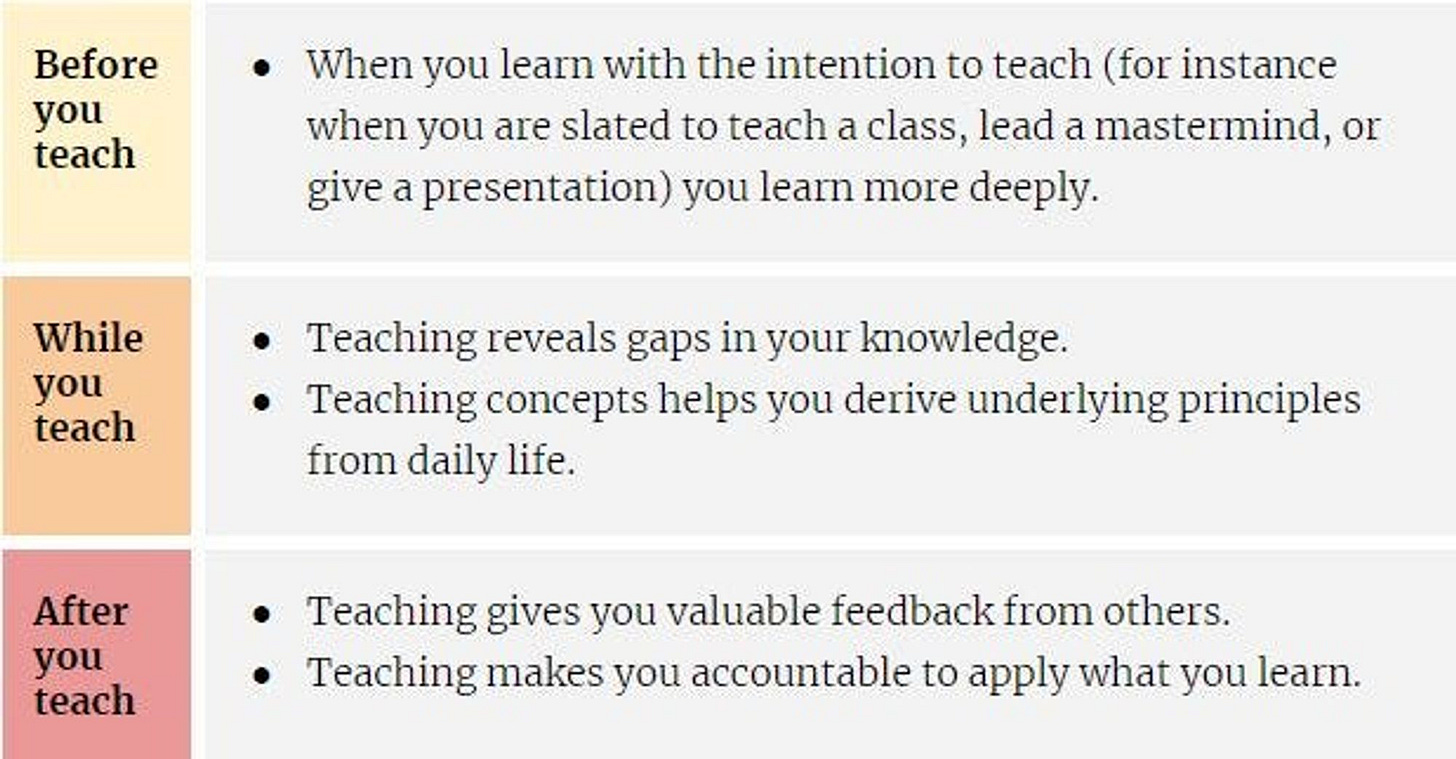
Despite these case studies and the mounting research, in today’s modern world, the value of teaching is drastically under-appreciated at all levels of society. I can think of no better example than the old saying we’ve all heard before:
Those who can, do; those who can’t, teach.
As a result of the research and case studies on the Explanation Effect, we can reframe this cultural meme toward something much more accurate:
Smart people do. Wise people do and teach.
Now that we understand WHY teaching to learn is so powerful, let’s dive into HOW we can actually take action to reap its value.
The Explanation Pyramid: Get More Learning From Teaching
When one teaches, two learn.
—Robert Heinlein
On the most basic level, explanation can be broken into two types:
Internal explanation, where we are simply explaining a concept to ourselves (journaling, mind mapping, thinking out loud, etc.) or to a simulated other in our head (rubber ducking).
External explanation, where we’re teaching one or more individuals informally (learning conversations, masterminding) or professionally (coaching, consulting, writing).
There are also levels within the internal and external levels:
As you move down the pyramid from internal to external, the benefits of the Explanation Effect mental model increase exponentially.
The increase is exponential because:
As you refine the knowledge in your head, you learn it more deeply until it becomes something you remember forever, apply automatically, and get great results within your own life.
As you move from internal to external, your lessons help other people — not just yourself.
As you move toward more professional forms of teaching and refine the quality of it, your lessons reach more people and have a profound impact.
As the quality of your knowledge and teaching improves, you can charge people or even take equity in a company if you advise a startup. It is easier than ever to get most of your income by teaching others as a coach, leader, manager, thought leader, therapist, teacher, facilitator, mentor, investor, advisor, speaker, writer, or consultant. (If that’s what you want, here’s a tested and proven way to get started.)
When you put it all together, it looks like this:
The Exponential Explanation Pyramid helps you think about a whole range of actions you can take to become a better learner.
Meanwhile, if you’re looking for something super simple to get started with so you can build momentum, I recommend the following teaching habit:
Get Started With This One Simple Daily Habit: The “Today I Learned” Journal
Teachers have three loves: love of learning, love of learners, and the love of bringing the first two loves together.
―Scott Hayden
The easiest way to get started with the habit of teaching is by creating a daily “Today I Learned” email. The idea is inspired by the popular Today I Learned subreddit. In this subreddit users share one big thing they learned that other users would find interesting. Then others comment or downvote/upvote it.
How It Works
Near the end of your day, spend 15 minutes writing down one big thing you learned during the day. This simple habit builds on the Harvard research that spending 15 minutes at the end of the day can increase your learning for the day by 23%.
The Two Versions
You can either just keep it for yourself or share it with others and invite them to share what they learned with you:
Simple version (single player): Write an email and send it to yourself — or just write it in a journal. If you want to go a step further, you can also ask yourself, “How can I turn this insight into action in my life?” This is the best physical learning journal I found.
Advanced version (multiplayer): Write down your lesson learned in some form of social media (email, Slack, Facebook, Medium, Instagram) and then share it with others—specifically tagging, at least one person who would get the most value. This advanced version forces you to add important context, so the lessons are valuable for others: (1) Why is this lesson so important that someone should stop their day to read about it? (2) What benefit will they get? (3) What is the big idea you’re teaching in simple terms? (4) How can others take action on the idea? The multiplayer version works best when it’s reciprocal, and you invite the people you share it with to share their lessons learned with you as well.
And, if you want to get started this minute, share one thing you’ve learned today in the comments.
Benefits
With the “Today I Learned” journal, you:
Learn faster. This happens because you cement a valuable piece of knowledge by reflecting on it and then teaching someone else.
Build deeper relationships. By sharing what you’re learning with others, you stay connected, and you help people grow in their own life.
Become better at teaching others. Every single day you share an email with someone, you get to practice teaching. In addition, you get feedback, which can improve your teaching ability.
Create a record of your lessons learned so you can look back on them. The “Today I Learned” journal allows you to chart your life’s learning journey. As you return to your daily lessons again over the years, you’ll notice how your answers change or don’t!
Case Studies
There are a lot of interesting variations of a “Today I Learned” journal that others have explored. Here are a few of the most interesting ones I found:
Hashrocket created a blog where employees post interesting things they learn about programming.
dxw digital created a slack channel where employees post lessons learned.
One student in our Learning Ritual course started a “Today I Learned” conversation with his daughter. Each day he lets her share something she learned. Then, he asks questions about it. Then the tables are reversed, and he teaches her something.
Thomas Edison just might be the king of the “Today I Learned” journal. He relentlessly recorded every single problem he worked on along with the corresponding lessons learned. Throughout his life, he collected over five million pages of these notes. Whenever one of Edison’s experiments succeeded, he would then review his old journals and use his new lessons to rethink old, stalled problems.
Teach What You Love Full-Time: Your Invitation
Share your knowledge. It is a way to achieve immortality.
― Dalai Lama
If you want to become a celebrity teacher, get a flood of “true fan” readers and customers, teach what you love full time, and transform the lives of others, here’s another action you can take right now…
In my article, The #1 Mental Model For Writers Who Want To Create High-Quality, Viral Content, I reveal the exact strategy I used to go from zero to tens of millions of views in publications like Forbes, Fortune, Time, and the Harvard Business Review — by simply teaching my best ideas for free. If you want to write high-quality, viral articles that make you a celebrity teacher, then you’ll love it.
If there’s a link to an Amazon book, it’s an affiliate link, which means I get a small amount of compensation when you buy the book. This compensation does not influence the specific books I recommend, as I only recommend books that I read and love.




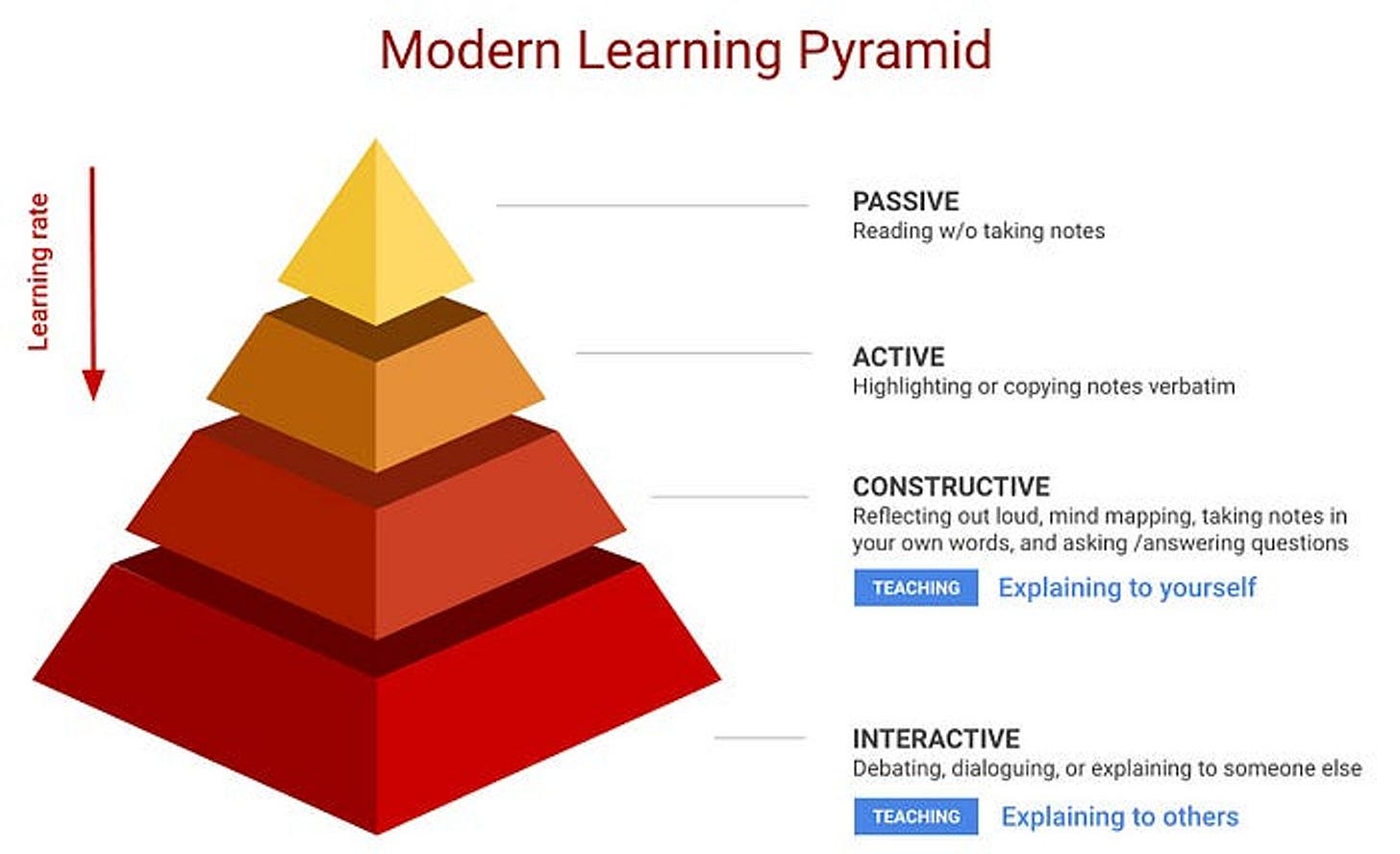
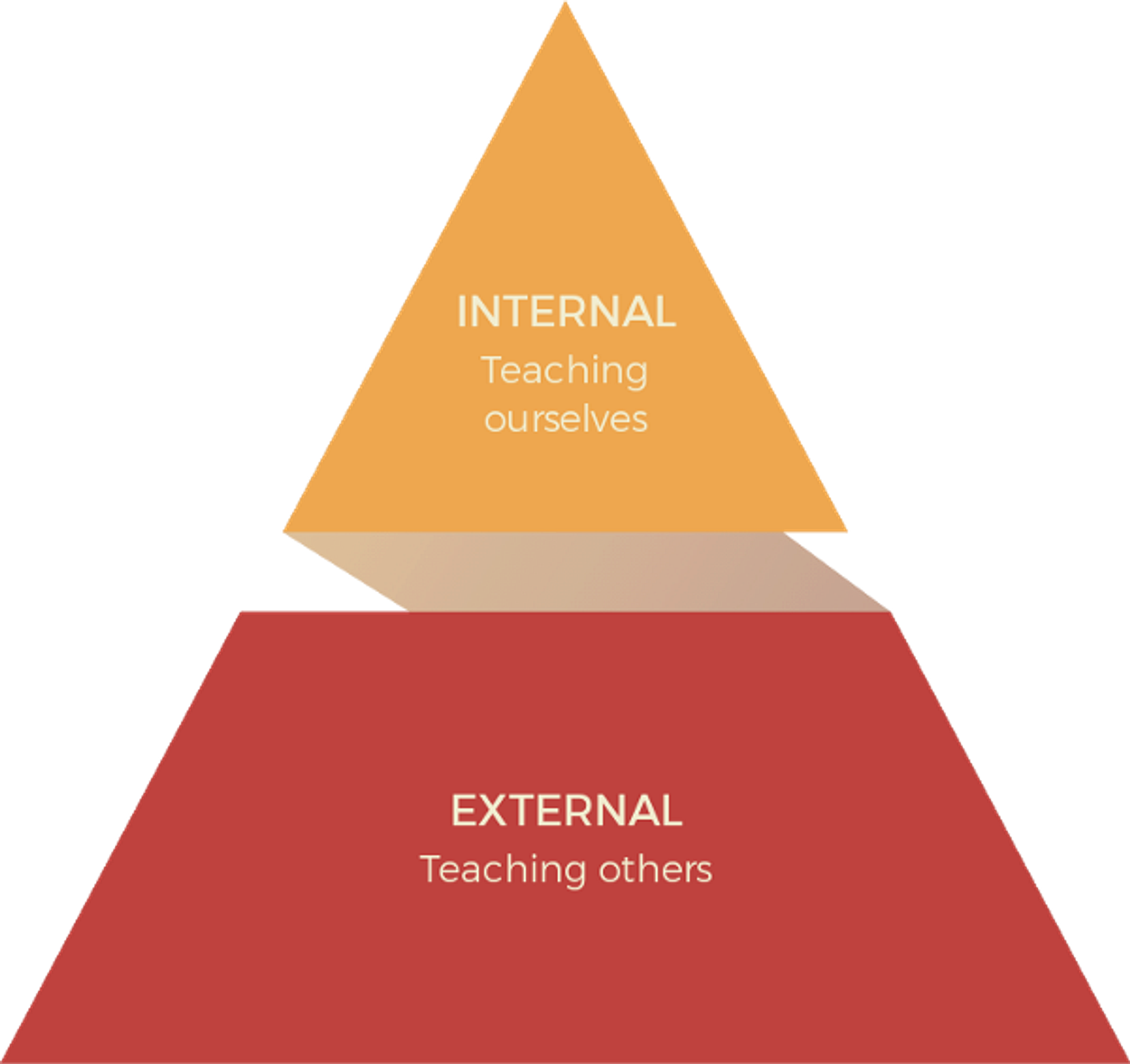
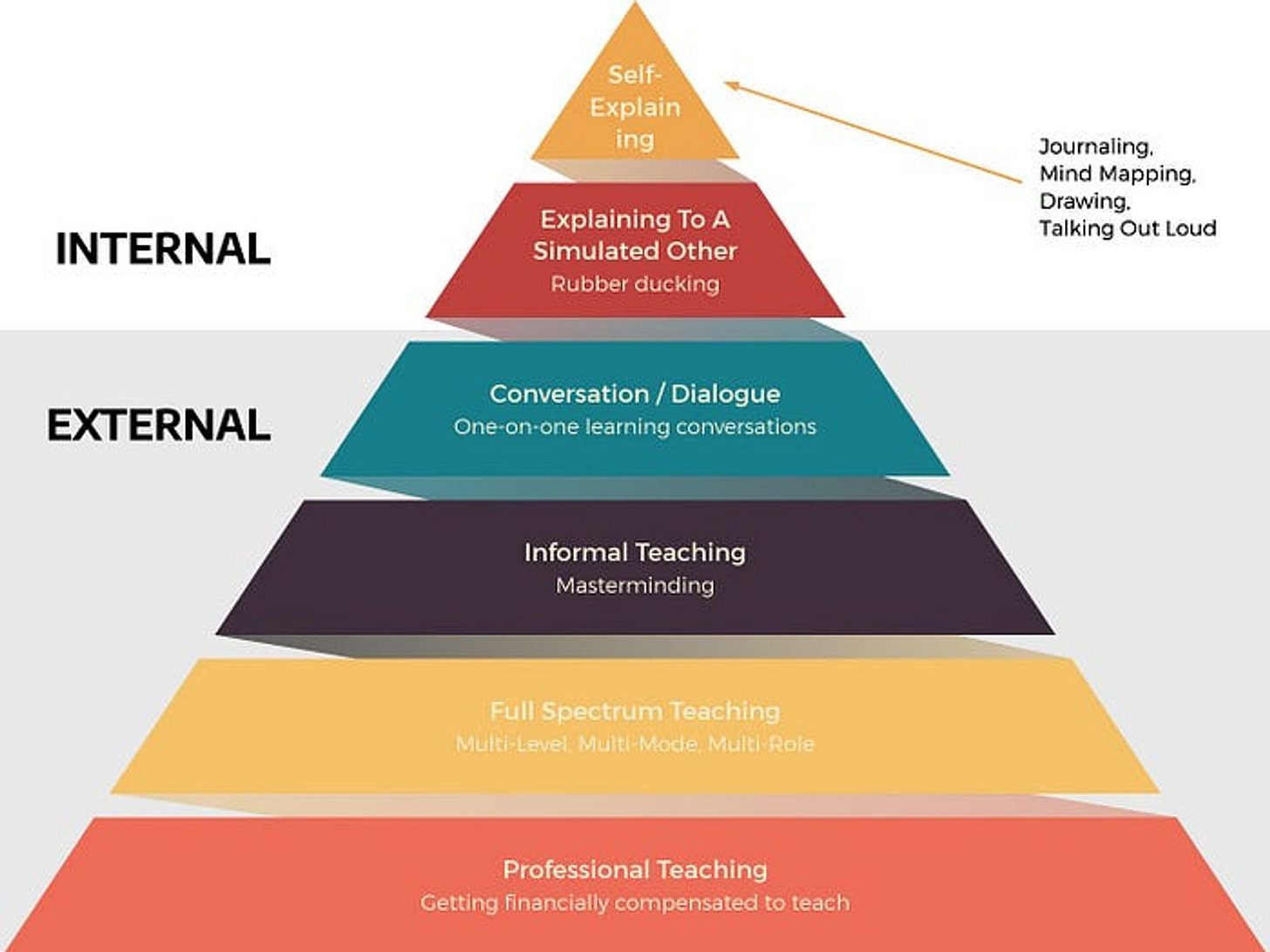
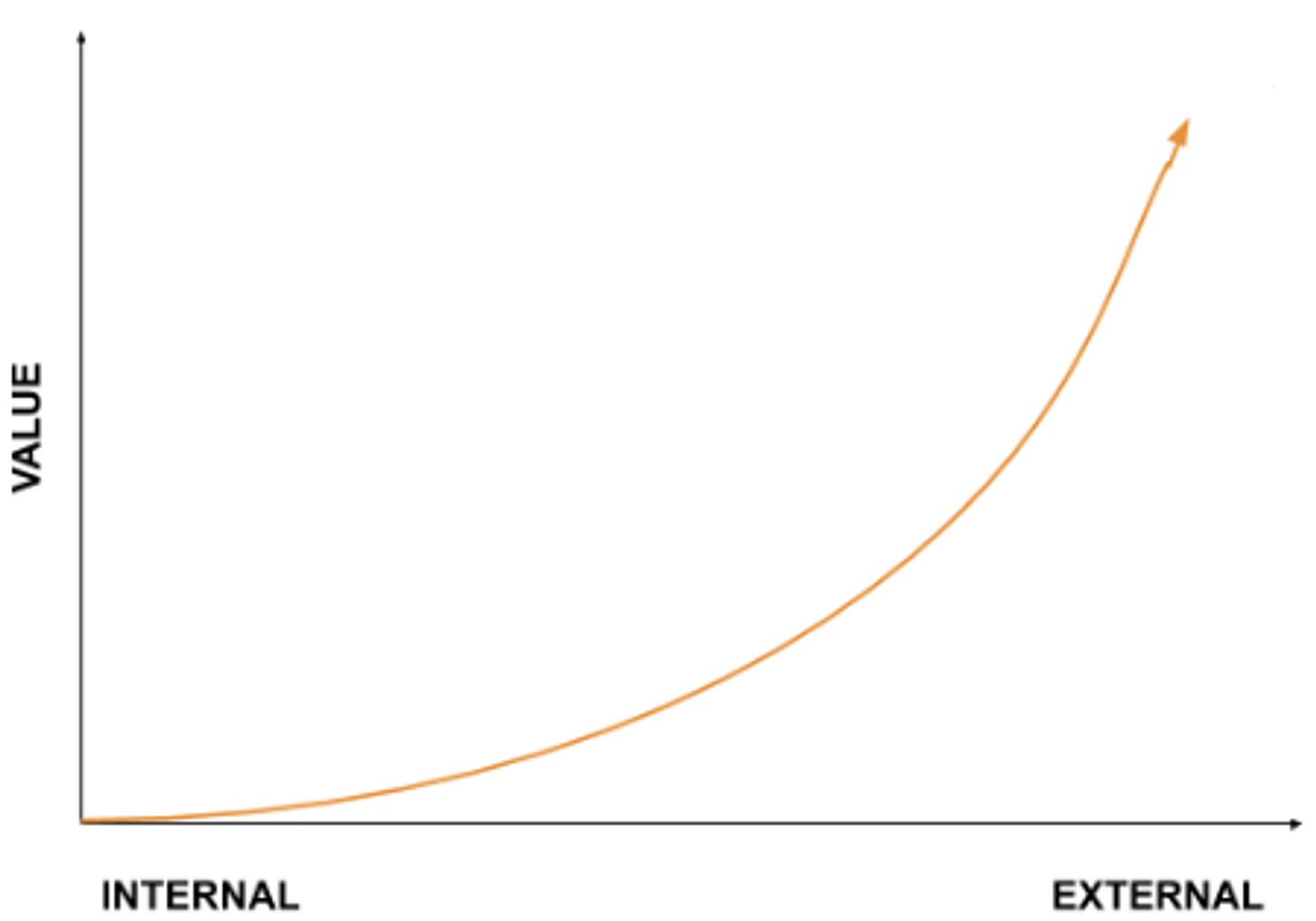
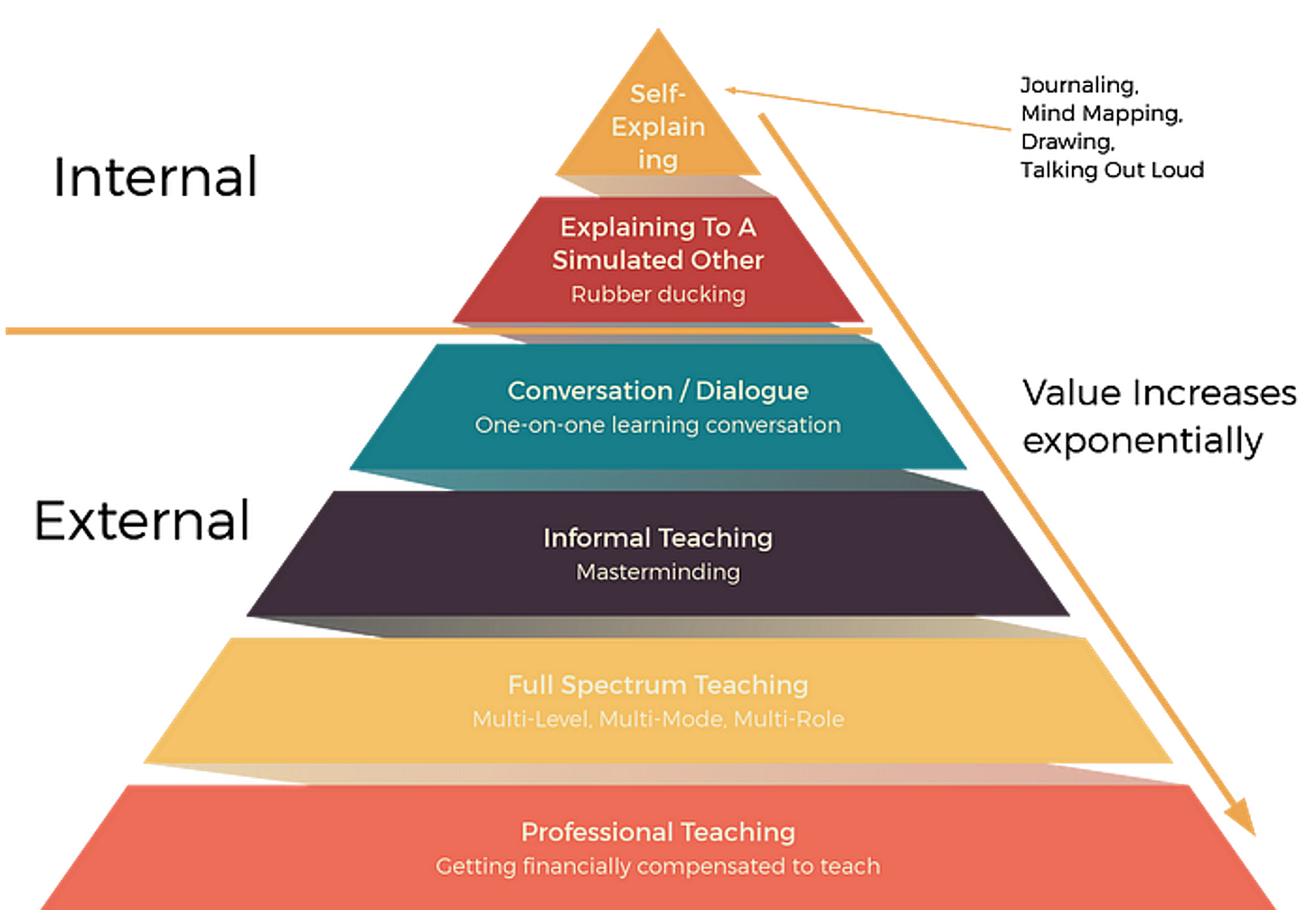
Model: The Ascent of Learning
Michael,
I enjoyed your article entitled: Memory & Learning Breakthrough: It Turns Out That The Ancients Were Right.”
I need to return to study your referenced article on the ICAP method . It explains that: "as activities move from passive to active to constructive to interactive, students undergo different knowledge-change processes and, as a result, learning will increase." (Chi and Wylie, 2014)
Below is a link to my reinterpretation of the Exponential Explanation Pyramid. It contains the identical content presented in the visual framework of a pyramid.
I describe this redesign as “The Ascent of Learning.”
https://drive.google.com/file/d/1TDQjD1LTZksSKoafiA3lSUxGQTy7_sSm/view?usp=sharing
John